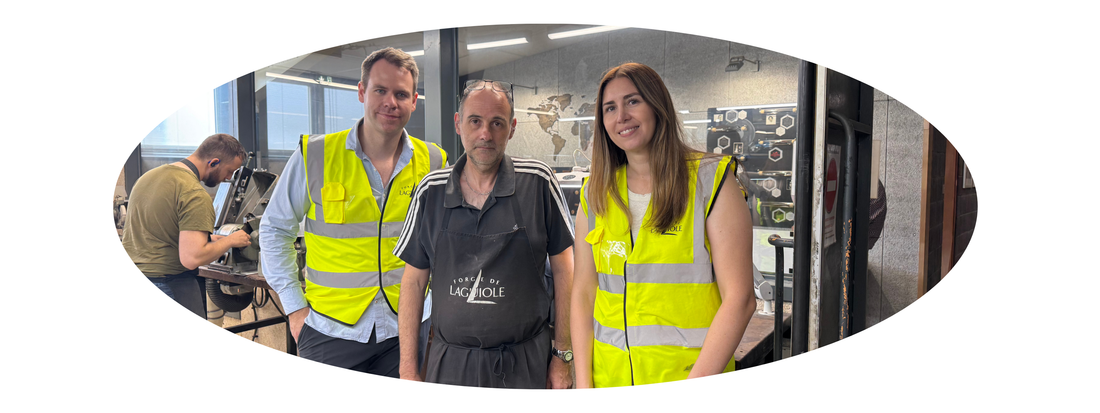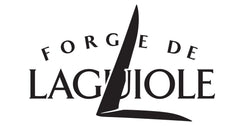
After having to postpone our previously planned visit in winter 2023 due to severe weather, we were excited to finally make it to the factory this year. For us, this was more than just a factory tour, it was an important opportunity to finally meet the creators and people behind the brand, in person, and to strengthen our business relationship with one of France’s most iconic luxury cutlery makers.
We were warmly welcomed by our dedicated sales representative, who had thoughtfully planned a full day for us. This itinerary included a comprehensive introduction to the production process, meetings with members of the team, and a very special activity arranged exclusively for us — something not typically available to visitors. But first, we had to drop off a few TimTams as well as a great Barossa Shiraz for the Team.
The Building
The Forge de Laguiole factory, designed by world-renowned French designer Philippe Starck, first opened its doors in 1987. Stretching 175 metres in an elegant L-shape. The building has already undergone two extensions to meet growing demand, with another expansion currently in the planning stage.
Starck’s architectural vision perfectly embodies the company’s philosophy — a harmonious blend of tradition and innovation. Using sleek glass and aluminium, he created a space that feels both modern and deeply connected to the heritage of Laguiole knife-making. The most striking feature is an 18-metre-high steel blade that rises above the factory, this 'blade' was once a plane wing.
Inside, the layout is designed for both functionality and transparency. Natural light floods the work areas, allowing visitors to witness the artisans at work during guided tours, while the building’s long, open lines create a sense of continuity between each stage of production.

Behind the Scenes of World-Class Craftsmanship
We began with a private, in-depth tour of the entire facility, allowing us to meet the majority of the staff and witness every stage of production.
First stop: The Entry & Boutique
The visit begins in the welcoming entry area, which also serves as the boutique. Here, you can see nearly the entire Forge de Laguiole collection displayed, from folding knives and table knives to corkscrews and unique limited editions. This is also where visitors can purchase products, including a small selection of second-choice knives at a reduced price — available only at the factory!

Metal Components Production
Our tour began in the section where all metal spare parts are made: bolsters, plates, springs, and every other component that will later be assembled into a finished product.

Forging & Hardening
The forging room sits slightly lower than the rest of the factory floor to accommodate the tall, 100+ year-old forging machinery. The forging process only happens twice a week — typically on Tuesdays and Thursdays — so if possible, plan your visit for one of those days. Unfortunately, due to scheduled maintenance, we didn’t get to witness forging in action this time.

It’s important to note that Forge de Laguiole forges in-house, unlike most others. The main forging hammer, over 100 years old, delivers an incredible 300 tonnes of pressure.

We did, however, witness the hardening process: blades are heated to 1,000°C for two hours, then quickly cooled in oil. This rapid quenching process gives the blades their strength and durability.
The Grinding Room
Next, each side of the blade is ground to ensure perfect alignment and straightness, preparing it for assembly.
Sawing & Handle Material Storage
While blades are being ground, the handle materials are cut to size.

One of our favourite stops was the handle material storage room — a treasure trove containing everything from rare exotic woods to horn, deer antler, and even mammoth ivory.
Interesting fact: All deer antlers used by Forge de Laguiole are naturally shed and collected from the forest floor — no animals are harmed in the process.

Assembly
Behind big glass panels — beyond the point where regular guided tours usually stop — is where most cutlers work. We were fortunate to see this process up close. Each cutler receives a list of products to complete that day, often in batches of 12 identical pieces (for example, 12 cheese knives or 12 folding knives). The complexity of the product dictates the workload — a simple table knife is far less intricate than a corkscrew with hinges and springs which need to perfectly align.

Shaping
Once assembled, the shaping begins. Depending on the model, cutlers work with 4–6 different abrasive belts, slowly refining the contours and profile until the knife’s form is perfected.

Polishing
The polishing stage takes place in a separate room, where high-speed polishing wheels demand heavy-duty protective coats for safety. We observed through a viewing window as cutlers applied either a satin or high-polish finish, depending on the order.

Engraving
If engraving is requested, it’s done now. Forge de Laguiole offers three engraving methods: diamond, laser, and deep laser — each suited to different materials and styles.
Cleaning
After polishing, most products undergo an ultrasonic cleaning treatment— ensuring every surface is spotless before final finishing. Its important to note that not all handle materials can be cleaned with ultrasound as they might break.
Quality Control
The final inspection is carried out by an experienced quality control team whose trained eyes can often identify the maker of a knife simply by the finish. Any product that fails to meet the standard is returned to the maker for correction, or in the worst case, recycled.

Sharpening
The very last step is sharpening — performed just before the knife leaves the factory to ensure safety during handling until it’s ready for use.
_____________________________________________________________________________
A Taste of the Region
At midday, we stepped out for lunch at L’Aubrac, a large and renowned local restaurant on the main road in Laguiole. On a Friday afternoon, the place was almost completely full, with over 300 guests enjoying classic regional cuisine. Naturally, we ordered the local specialty, Aligot — a must-try!
_____________________________________________________________________________
An Exclusive Knife-Making Experience
Returning to the factory, we were met with the day’s surprise: the chance to make our own folding knives and chisel our very own collection knife spring & bee. This was an incredible privilege — a rare exception that Forge de Laguiole does not offer to the public.
Our daughter, who had been minded all morning by her grandfather, eventually lost her patience with him — so we had to bring her along to the workshop in the afternoon. Understandably, a knife-making factory is not like Disneyland for a four-year-old, but she held it together better than expected. Thankfully, her patience was rewarded a few days later with a visit to the actual Disneyland Paris, a far more suitable adventure for a little one her age.


Under the patient and expert guidance of Daniel, one of the highly skilled cutlers, we worked step-by-step through the assembly, shaping, and finishing processes. Daniel was incredibly nice and friendly, taking his time to deeply explain each stage of the knife-making process in great detail. His expertise was essential in ensuring the pieces were completed to the exact Forge de Laguiole standard, patiently correcting a few of our mistakes along the way.
After nearly three hours of explaining, guiding, and fixing our errors, the effort clearly took its toll. He looked a little exhausted by the end, as you might be able to tell from the photo. 🫣 😂

Most customers only ever see the finished product but it is important to understand the tremendous amount of work that goes into every single piece. We only produced the “easier” version — a single-blade folding knife and a hand chiseled bee — yet it still required immense precision and care. When it comes to three-piece folding knives, which also feature the awl and corkscrew, or models like the golf knives and corkscrews, the complexity increases dramatically. Each moving part must align and function with absolute perfection, which requires these multi-component pieces an entirely different level of craftsmanship.
The experience truly highlighted just how much precision, patience, and skill are required to master this craft. It takes a minimum of three years of apprenticeship before an artisan can finally call themselves a cutler.
What stood out most throughout the whole day was the pride and passion each staff member showed when explaining their role. These are true masters of their craft, fully aware that their work will go on to grace the tables of the world’s most prestigious restaurants and even celebrity households.
Stéphane Rambaud
We were also honoured with the opportunity to step inside the workshop of Stéphane Rambaud, Forge de Laguiole’s master cutler. His creations blur the line between functional tools and high-end jewellery. Each piece is a one-of-a-kind requiring, in some cases, over 100 hours of meticulous craftsmanship. Stéphane’s passion for his work is infectious, and he generously shared details of his current projects. Almost anything is possible within his creative process. Some of his work remains discreet, certain clients, often well-known public figures prefer their commissions to stay private.
Extremely Grateful & Looking Ahead
We concluded the visit with discussions with the production managers, where we talked about upcoming projects and exciting developments that we look forward to sharing soon.
The Forge de Laguiole factory is open year-round to visitors, offering guided tours that give an excellent overview of the knife-making process. Click here for more information.
We could not have been more grateful to Karine and Céline for their incredible hospitality and generosity throughout the day — especially to Karine, who quite literally spent the entire day with us. She organised everything with such care, from the factory tour and lunch to the hand-chiselling session (and even a bit of child-minding on the side). Her kindness and warmth made the experience truly unforgettable.
We are already looking forward to returning next year to spend more time in the idyllic Aubrac region — to finally visit the famous cheese factory, enjoy a few of the renowned local restaurants, take in the rolling hills, and hopefully explore more of the countryside by bicycle.

